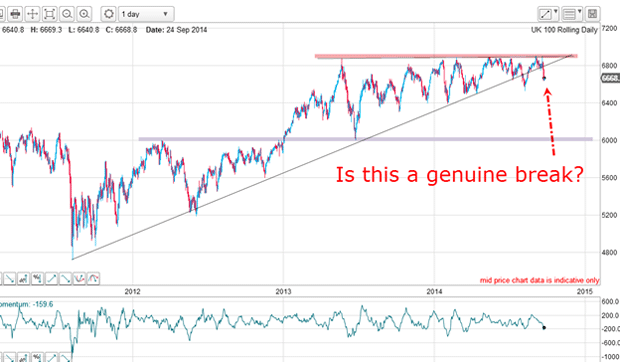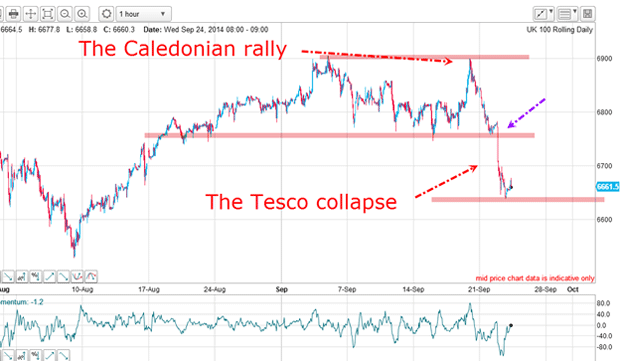Tesco – the shot heard around the financial world
The bad news from Tesco sent the stock market tumbling. But that was just for starters, says John C Burford. Expect more to come.
Last Wednesday, I wrote: "This is an important week in the markets, make no mistake. As we approach the end of September traditionally one of the weakest months for stock markets there are several events that are potentially market-changing."
And events since then have confirmed my prognosis in spades.
On Wednesday, all was serene in the ongoing bull market, but I detected divisions under the surface from my technical studies. Today, I will review a few of these recent events.
MoneyWeek
Subscribe to MoneyWeek today and get your first six magazine issues absolutely FREE

Sign up to Money Morning
Don't miss the latest investment and personal finances news, market analysis, plus money-saving tips with our free twice-daily newsletter
Don't miss the latest investment and personal finances news, market analysis, plus money-saving tips with our free twice-daily newsletter
Stimulus versus deflation: Has the tide turned?
This year is the centenary of the start of World War I, which is being commemorated widely in the UK. Many view the assassination of Archduke Franz Ferdinand of Austria as the catalyst that brought the major powers into conflict.
The gun that was used in that killing was said to have fired the shot that was heard across the world.
I am unable to resist the comparison with Monday's revelation that Tesco one of the world's great business success stories (and a supposed pillar of probity) had overstated its profit figures by a very large margin.
The stock, which had already fallen from around 380 a year ago to the current 190 a decline of a massive 50% was naturally hit very hard.
The war is now on between the mighty forces of stimulus and deflation. Up to last week, the stimulus camp had won every battle. But has the tide now turned?
Is it a genuine break this time?
My first thought when I heard the Tesco news was that the stock market was finally starting to face reality that much of the five-year bull market was built on a mania of blind faith that stocks could only go one way up.
My second thought was that market sentiment can truly turn on a dime and the catalyst can usually be something completely unexpected.
Here is the daily FTSE:

The horizontal triangle (wedge) has been broken again. But the memory of the August head fake lingers and so my question is this: is it a genuine break this time?
Because if it is, there should be a very swift run-down to the start of the wedge in the area of the grey support zone at the 6,000 level. That would imply a decline of 13% off the 6,900 high.
Tesco is one of the FTSE 100 components and on Friday, it was knocking on the door of a major new high at the 6,900 level. Today, it is almost 4% lower.
The FTSE is one the most tightly regulated and honest' of stock markets and now suddenly there are fears over shady practices in one of the pillars of UK business.
That perfectly illustrates the principle that it is usually something out of left field that hits at market tops, not what most are tracking.
While most eyes have been on corporate profits, interest rates and Fed policy for clues as to stock market direction, was anyone expecting this from Tesco of all companies?
Will the bull market keep climbing the wall of worry?
Now that there are new-found fears emerging over the very integrity of basic corporate reports, can the bull market throw them off as it has for so many other negative issues and continue climbing that wall of worry?
In my postof 17 September, where I reviewed several stock indexes, this is what I said of the FTSE: "One of the features of this pattern (the horizontal wedge) is that if the market can break upwards, the thrust is usually quickly retraced. And if it breaks to the downside, the move is usually very sharp as the mountain of sell-stops placed under the many lows are touched in a cascade of selling".
It appears the blue touch paper has indeed been lit. But isn't that ironic just when investors were celebrating the bullish Scotland No win on Friday (and pushing the FTSE up to 6,900), their enthusiasm was dashed on the Tesco rocks the next trading day?
One other straw in the wind is the initial public offering (IPO) of the year if not the century Alibaba.
With massive hype, it was launched on Friday and quickly ran up to $99.50 way above its issue price. But since then, selling has produced a drop of 13% off the top so far.
Remember, investors are not dealing in the shares of the company, but in an offshore entity that has a contract to receive the dividends of the main company. How long the Chinese authorities will permit this is an open question. The risk of disappointment is high.
Is the Tesco shot the first of many?
So, where was the trade in the FTSE? Here was one opportunity:

The centre pink zone has been major support since mid-August, and its break provided a short trade signal (at the blue arrow). The cascade of stop-loss selling, which I expected, is plain to see.
This morning, the market has reached a target if the pink zones are considered as horizontal tramlines. A bounce of some sort is on the cards. But the centre zone becomes resistance to rallies. A resumption of the decline below the lower pink zone would set my next target at the 9 August low in the 6,500 area.
As the stock market decline extends, I am sure more revelations of shady company dealings will be revealed as social mood turns more negative. And this is occurring right now with the drums of war over Iraq and Syria beating once more.
The Tesco shot was very likely the first of many.
Get the latest financial news, insights and expert analysis from our award-winning MoneyWeek team, to help you understand what really matters when it comes to your finances.
John is is a British-born lapsed PhD physicist, who previously worked for Nasa on the Mars exploration team. He is a former commodity trading advisor with the US Commodities Futures Trading Commission, and worked in a boutique futures house in California in the 1980s.
He was a partner in one of the first futures newsletter advisory services, based in Washington DC, specialising in pork bellies and currencies. John is primarily a chart-reading trader, having cut his trading teeth in the days before PCs.
As well as his work in the financial world, he has launched, run and sold several 'real' businesses producing 'real' products.
-
 The shape of yields to come
The shape of yields to comeCentral banks are likely to buy up short-term bonds to keep debt costs down for governments
-
 The sad decline of investment clubs – and what comes next
The sad decline of investment clubs – and what comes nextOpinion Financial regulation and rising costs are killing off investment clubs that once used to be an enjoyable hobby, says David Prosser